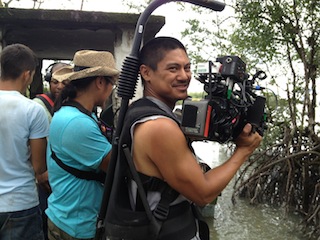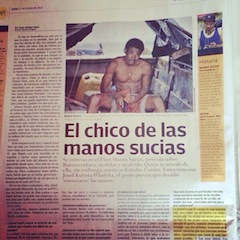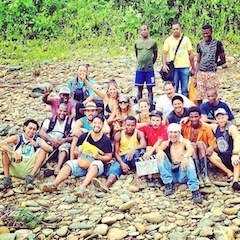 Equatorial heat and humidity, sporadic electrical service, and a modest budget were just a few of the challenges that director Josef Wladyka and writer/DP Alan Blanco faced while filming their feature Manos Sucias (Dirty Hands) among the impoverished fishing villages of Colombia’s Pacific coast. Filmed completely on location, Manos Sucias is a drama depicting the perils of two fishermen coerced into towing an underwater narco-torpedo up the Pacific coast of Colombia. They also filmed in the jungle and aboard small boats in rough seas, all while needing to keep a low profile in a dangerous region.
Equatorial heat and humidity, sporadic electrical service, and a modest budget were just a few of the challenges that director Josef Wladyka and writer/DP Alan Blanco faced while filming their feature Manos Sucias (Dirty Hands) among the impoverished fishing villages of Colombia’s Pacific coast. Filmed completely on location, Manos Sucias is a drama depicting the perils of two fishermen coerced into towing an underwater narco-torpedo up the Pacific coast of Colombia. They also filmed in the jungle and aboard small boats in rough seas, all while needing to keep a low profile in a dangerous region.
Wladyka and Blanco met all of these challenges with the help of compact Canon EOS C300 Cinema cameras and professional lenses.
“The Canon EOS C300 Cinema camera was a great fit for this project,” Blanco said. “It gave us fabulous, robust imagery and it fits into a backpack. Many digital cinematography cameras are like computers with cameras attached to them. You have to boot them up, and in the two minutes it would have taken us to do that we could have lost the shot. The EOS C300 is a camera first and foremost, and that’s what we love about it. We were in very unpredictable places, but I could turn the EOS C300 camera on and be ready to roll.”
With bodies weighing just over three pounds, the two Canon EOS C300 Cinema cameras – and an assortment of Canon CN-E Series Cinema prime lenses and Canon EF-Series zoom lenses – enabled Wladyka, Blanco, and their small crew to carry their own gear, maintaining a highly mobile and naturalistic hand-held production style. Far from any rental house or other support services, they say that larger cameras might not only have bogged them down, but could have been disastrous while shooting in stilted houses built on pilings over Buenaventura harbor. “Heavy equipment could have fallen right through the floor and into the bay,” Blanco explained.
“The Canon EOS C300 Cinema camera was a Godsend for us in those locations,” Wladyka said. “It is very ergonomic, with a small body that let me place it in different parts of a moving taxi-van, or alongside a moving boat, or in a cramped jungle area. It doesn’t have a large profile that prevented me from being able to handle it the way I wanted to, which helped maintain a lot of the energy and claustrophobia we were going for in certain scenes.”
 The Canon EOS C300 Cinema camera is equipped with the Emmy Award winning high-sensitivity Canon Super 35mm CMOS sensor, outstanding Canon DIGIC DV III image processor, and a 50 Mbps 4:2:2 MPEG-2 codec for superb cinematic picture quality. The EOS C300 Cinema camera is engineered to deliver full 1920 x 1080 HD and provides a selectable ISO range up to 20,000 for outstanding low-light performance.
The Canon EOS C300 Cinema camera is equipped with the Emmy Award winning high-sensitivity Canon Super 35mm CMOS sensor, outstanding Canon DIGIC DV III image processor, and a 50 Mbps 4:2:2 MPEG-2 codec for superb cinematic picture quality. The EOS C300 Cinema camera is engineered to deliver full 1920 x 1080 HD and provides a selectable ISO range up to 20,000 for outstanding low-light performance.
“The Canon EOS C300 Cinema camera’s image definitely gave us a lot of play room in post to fix and accentuate things and maintain a really strong cinema look,” Blanco confirmed, noting that he recorded all footage in Canon Log Gamma. This setting captures the full exposure latitude that the camera’s Super 35mm CMOS sensor is capable of delivering for film-style dynamic range between shadows and highlights, which is essential for achieving cinematic subtleties in post-production color grading.
“Canon Log gave us a lot of great latitude, color, and saturation while also maintaining a very small media size,” Blanco said. “We could shoot all day on CF cards that fit in your pocket and not have to immediately download to hard drives in places that didn’t have reliable electricity. We were able to wait until we got back to home base to download the cards because the files themselves were not huge, yet they made an image that was really strong.”
“Shooting on the camera’s CF cards was a great experience,” Wladyka added. “It made it easier and quicker to shoot. Our entire cast was basically from the Buenaventura area, and I wanted to capture as much ‘life in front of the camera’ as possible, so we were rolling all the time. Recording to CF cards let us do a lot of takes, a lot of improvising. I could keep the camera rolling and didn’t need to call ‘Cut!’ That kind of technique was perfect for this kind of film.”
“The Canon EOS C300 is definitely a moviemaking camera, made for shooting motion footage,” he said. “Despite all the logistical challenges, I was never willing to sacrifice a big-screen, cinematic look, and the Canon EOS C300 camera was perfect to meet all our requirements.”
Designed with input from the worldwide motion picture community, the Canon EOS C300 Cinema camera is engineered to integrate features that serve the unique requirements of filmmakers. Examples include 15 customizable control buttons and a removable four-inch 1.23 megapixel LCD monitor that rotates 135 degrees left/right or 270 degrees down and is mountable directly on the camera body or to a removable top-handle.
 “Being able to change the location of the camera’s LCD monitor to pretty much accommodate all various shooting positions was very convenient,” Blanco said. “I was also very glad to have everything I wanted where and when I needed it at the touch of a button. That included a magnify button to allow me to check my critical focus during a take. I could change the customizable buttons quickly if I needed to hold the camera in some special way to shoot off my shoulder, or my hip, or while hanging off of a boat. I think some of the other digital cinematography cameras just would not have worked for us. It would have been ridiculous if I had to go through touch-screen menus to try to change a camera feature when it’s humid and sweaty and there’s saltwater everywhere.”
“Being able to change the location of the camera’s LCD monitor to pretty much accommodate all various shooting positions was very convenient,” Blanco said. “I was also very glad to have everything I wanted where and when I needed it at the touch of a button. That included a magnify button to allow me to check my critical focus during a take. I could change the customizable buttons quickly if I needed to hold the camera in some special way to shoot off my shoulder, or my hip, or while hanging off of a boat. I think some of the other digital cinematography cameras just would not have worked for us. It would have been ridiculous if I had to go through touch-screen menus to try to change a camera feature when it’s humid and sweaty and there’s saltwater everywhere.”
“Yet another great feature of the Canon EOS C300 Cinema camera is its built-in six-stop ND filters, which we used a lot,” he said. “They allowed us to shoot the camera at its native ISO so we didn’t waste any of its big 35mm CMOS chip, but still cut down the light enough so that we could open up the Canon Cinema lenses to a nice thin stop. This allowed us to get a really beautiful cinematic look of bokeh and shallow depth-of-field, even though we were shooting in broad outside daylight near the equator. That was really helpful.”
“Another thing I really like is that the EOS C300 camera is also very modular and customizable,” Blanco continued. “All the third-party accessories that you can get all fit and work seamlessly. In addition to a portable camera support system, we also used an external LCD monitor, plugged into the camera’s HD-SDI port that our first AC used with a wireless follow-focus unit. We also had a wireless transmitter for a remote monitor that let Joe see his actors even when he had to be some distance away, down the street or in the camera boat out in the harbor.”
Also crucial to the Manos Sucias production style was the low-light capabilities of the Canon EOS C300 Cinema camera, Blanco said. “A large lighting department needs a big crew, which wouldn’t have worked for our stealthy filmmaking style,” he said. “We also needed to shoot interiors to show the home life of our characters, but many of those places didn’t have dependable electricity, so movie lights would have been dangerous. Being able to use natural lighting with our Canon EOS C300 Cinema cameras and Canon lenses definitely helped us shoot what we wanted while also staying safe.”
 Blanco noted how the low-light advantages of the Canon EOS C300 Cinema camera also enabled him to capture the unique quality of equatorial sunlight at specific times of the day. “Blue hour – when the light is starting to fill the sky but just before there is direct sun – is gorgeous,” he said. “The EOS C300 cameras and our Canon lenses are so fast we were able to get really beautiful blue hour images as the main characters were shoving off in the morning to tow their torpedo, and when they were putting up for the night, building camp.”
Blanco noted how the low-light advantages of the Canon EOS C300 Cinema camera also enabled him to capture the unique quality of equatorial sunlight at specific times of the day. “Blue hour – when the light is starting to fill the sky but just before there is direct sun – is gorgeous,” he said. “The EOS C300 cameras and our Canon lenses are so fast we were able to get really beautiful blue hour images as the main characters were shoving off in the morning to tow their torpedo, and when they were putting up for the night, building camp.”
“Our two mounted LED light panels, follow-focus, external monitor, and other accessories all had their own power needs and drained our external batteries. The Canon EOS C300 Cinema camera, however, was basically powered all day by four Canon batteries – and that was with the higher shooting ratio we were going for with improv to capture performances. When it came to batteries, it was never the camera that slowed us down.”
Lenses used to shoot Manos Sucias included three Canon Cinema prime lenses (the CN-E24mm T1.5 LF, CN-E50mm T1.3 LF, and the CN-E85mm T1.3 LF) and four Canon EF-series zoom lenses (the EF-S 10-22mm f/3.5-4.5 USM, EF-S 17-55mm f/2.8 IS USM, EF 70-200mm f/2.8L IS II USM and the EF 100-400mm f/4.5-5.6L IS USM).
“The really great thing about using the EF lens mount version of the Canon EOS C300 Cinema camera is that we were able to use the Canon still-photo lenses we already had and were comfortable with,” Blanco said. “Canon glass has a long tradition for beautiful photography both in the way it articulates color and in its sharpness. I also like the Canon Cinema lenses because they are comfortable to use, versatile for filmmaking, and super-fast; they opened past T2, which allowed us to have super shallow depth-of-field to maintain a cinema kind of look. They also enabled us to maintain the same image quality we always had from our Canon L-series glass. Pulling focus, for example, was much more intuitive with the clearly engraved footage marks on the lens barrels. The gearing on those Canon Cinema prime lenses is also great because it allowed us to attach the Preston wireless focus-pulling unit for those times when I was either running or too far away from our first AC for him to pull focus.”
 “Joe and I developed a naturalistic look for Manos Sucias, but we also wanted to make bold, aesthetic choices for certain sections of it, building different visual motifs,” Blanco said. “Some of these were wide tracking shots from behind our performers, allowing us to immerse the audience into their world. As much as we all love a shallow depth-of-field, I also wanted to show – and Joe wanted to develop – the unique ‘world’ of Buenaventura, Colombia. We used the 24mm Canon Cinema prime a lot behind our performers as they reluctantly became immersed in the smuggling scheme. I tracked the performers through the jungle and through the city, and the gearing on the Canon Cinema prime let us use the wireless focus-pulling unit.”
“Joe and I developed a naturalistic look for Manos Sucias, but we also wanted to make bold, aesthetic choices for certain sections of it, building different visual motifs,” Blanco said. “Some of these were wide tracking shots from behind our performers, allowing us to immerse the audience into their world. As much as we all love a shallow depth-of-field, I also wanted to show – and Joe wanted to develop – the unique ‘world’ of Buenaventura, Colombia. We used the 24mm Canon Cinema prime a lot behind our performers as they reluctantly became immersed in the smuggling scheme. I tracked the performers through the jungle and through the city, and the gearing on the Canon Cinema prime let us use the wireless focus-pulling unit.”
“The Canon EF still-photo lenses were also great for getting some very specific looks,” Blanco continued. “The EF-S 10-22mm ultra-wide zoom gave us a bold look comparable to what we would have gotten with a particular third-party cine lens that would have been very cost-ineffective. On the other end of that was the EF 100-400mm telephoto zoom, which came in handy when we were on a boat shooting our performers in the other boat many yards away.”
Yet another advantage of three of the Canon EF-series zoom lenses Blanco and Wladyka used on board boats in Buenaventura harbor was their built-in Canon Image Stabilizer technology. “They are all stabilized optically inside the lens barrel, which is different than trying to steady the image after it’s captured,” Blanco noted. “The Image Stabilizer in the lenses really helped keep our footage steady.”
“We needed every bit of support we could get to green light Manos Sucias. The generous grant from Canon that our producers Elena Greenlee and Márcia Nunes accessed through Film Independent went a long way to getting this story on the screen,” Wladyka concluded. “Joe had been there first and learned about conditions from the local community, which inspired our script. The hospitality and generosity of the people in the area ultimately allowed Manos Sucias to be made. They want the world to know their story, and the Canon EOS C300 Cinema camera and Canon lenses gave us the low profile and versatility we needed to do that.”
